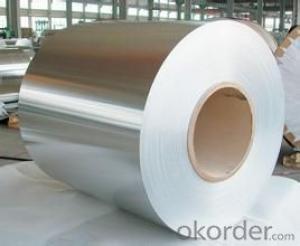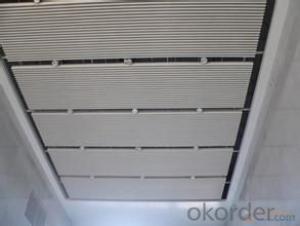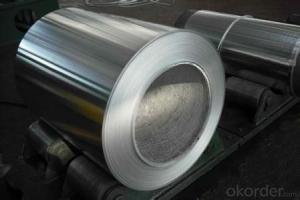Alu coil for roofing
- Loading Port:
- China Main Port
- Payment Terms:
- TT OR LC
- Min Order Qty:
- -
- Supply Capability:
- -
OKorder Service Pledge
OKorder Financial Service
You Might Also Like
Aluminium is a relatively soft, durable, lightweight, ductileand malleablemetalwith appearance ranging from silvery to dull gray, depending on the surfaceroughness. It is nonmagnetic and does not easily ignite. A fresh film ofaluminium serves as a good reflector (approximately 92%) of visible lightand an excellent reflector (as much as 98%) of medium and far infraredradiation. The yield strength of pure aluminium is 7–11 MPa,while aluminium alloys have yield strengths ranging from200 MPa to 600 MPa. Aluminium has about one-third the densityand stiffness of steel. It is easily machined,cast, drawn and extruded.
Aluminium alloys (or aluminum alloys; see spellingdifferences) are alloysin which aluminium(Al) is the predominant metal. The typical alloying elements are copper, magnesium,manganese,silicon,tin and zinc. There are twoprincipal classifications, namely casting alloys and wrought alloys, both of which are furthersubdivided into the categories heat-treatableand non-heat-treatable. About 85% of aluminium is used for wrought products,for example rolled plate, foils and extrusions.Cast aluminium alloys yield cost-effective products due to the low meltingpoint, although they generally have lower tensile strengthsthan wrought alloys. The most important cast aluminium alloy system is Al–Si,where the high levels of silicon (4.0–13%) contribute to give good castingcharacteristics. Aluminium alloys are widely used in engineering structures andcomponents where light weight or corrosion resistance is required
Specification:
Alloy: AA1050, 1060, 1100,AA3003, 3005, 3015, 5052, 5754, 5083,8011, etc
Temper:H14/16/18/22/24/32, HO etc.
Thickness:0.2mm—100mm
Width: 100mm—2300mm (Can be slitted)
InnerDiameter: 508MM
Coil Weight:500kg-3000kg(Max.)
Application:Foil stock, Circles, Roofing, Can stock, Marine plate,Anti-slipery purpose in vehicles, packing and appliance.
Features:
1. Excellent quality of products
2. Quick delivery
3. Best service to clients
4. BV,SGS avalible
5. No buckle o waveness
6. Tension leveling
7. Certificate of Origin
8. Form A,E
Packaging Detail:
Carton ,Woodenpallet with plastic protection packing ,standard seaworthy packing or as yourrequest.
ProductionCapacity:
AnnualProduction capacity of 600,000 tons.
Products areexported to United States, Canada, U.A.E, Brazil, Mexico,Thailand, Vietnam,Nigeria etc, over 100 countries andregions all over the world.
Production Line:
CNBM aluminumproduction base is comprised of 18 aluminumannealers, 10 coil and foilmills, 4 continuous production lines, 2hot rolling production line and 3prepainted lines.
FAQ:
1. What is the form of payment?
Normally 30% TT, L/C
2. Type of quotation?
FOB, CFR, CIF
3. Port of loading?
Shanghai port
4. Delivery time?
30 day after client’s deposit
- Q:An aluminum bar 3.80 m long has a rectangular cross section 1.00 cm by 5.00 cm, what is the resistance and what is the length of a copper wire 1.50 mm in diameter having the same resistance?
- Resistance equals resistivity times length divided by cross-sectional area. R = ρ?l/A The resistivities at 20°C are aluminum ρ = 2.82×10??Ωm copper ρ = 1.72×10??Ωm So the aluminum bar with rectangular cross section has a resistance of R = ρ?l/(a?b) = 2.82×10??Ωm ? 3.8m / (0.01m ? 0.05m) = 2.1432×10??Ω The resistance of copper wire with circular cross section is given by R = ρ?l/(π?d?/4) = 4?ρ?l/(π?d?) Hence a wire of same resistance as the aluminum bar has a length of l = R?π?d? / (4?ρ) = 2.1432×10??Ω ? π ? (0.0015m)? / (4?1.72×10??Ωm) = 0.0220m = 2.2cm
- Q:Can aluminum coils be used in the production of household appliances?
- Household appliances can indeed utilize aluminum coils in their production. Aluminum, a material known for its lightweight and durable nature, boasts exceptional thermal conductivity, rendering it highly suitable for various appliance applications. Refrigerators, air conditioners, and heat pumps, for instance, greatly benefit from the utilization of aluminum coils. These coils are commonly employed in the condenser and evaporator coils of such appliances, efficiently facilitating heat transfer. Moreover, the corrosion resistance of aluminum coils is pivotal in ensuring the longevity and optimal performance of household appliances. Consequently, owing to their advantageous properties and benefits, aluminum coils remain a favored option in the production of household appliances.
- Q:How are aluminum coils coated or treated for specific applications?
- To cater to specific applications, various methods are employed to coat or treat aluminum coils. One commonly used approach involves the application of a protective coating, such as a polymer or paint, to enhance durability and resist corrosion. This coating is typically applied through a process known as coil coating, which evenly spreads a thin layer of coating material onto the surface of the aluminum coil. The coil coating process consists of several steps. Firstly, the aluminum coil undergoes a cleaning procedure to eliminate any impurities or contaminants. This step is crucial in ensuring that the coating adheres properly to the metal surface. Following the cleaning process, a chemical pre-treatment is applied to the coil to enhance bonding between the aluminum and the coating material. Once the pre-treatment is complete, the coil is fed through a coating machine where the coating material is applied. The choice of coating material, whether it be liquid paint, powder coating, or a thin film, depends on the specific requirements of the application, such as desired appearance, durability, or chemical resistance. After the coating is applied, the coil is subjected to a curing process, which may involve baking the coil at high temperatures or exposing it to ultraviolet light. This curing process ensures that the coating material adheres effectively to the aluminum surface, providing excellent protection and longevity. In addition to protective coatings, aluminum coils can also undergo other treatments for specific applications. An example of this is anodizing, a process that creates a thick, durable oxide layer on the surface of the aluminum. Anodizing enhances corrosion resistance, improves aesthetics, and can also serve as a base for further coatings or treatments. Furthermore, aluminum coils can be laminated with other materials for specific applications. For instance, they can be laminated with plastic films or adhesive coatings to provide insulation, moisture resistance, or other special properties. In conclusion, aluminum coils are coated or treated in various ways to meet the requirements of specific applications. Protective coatings, such as polymer or paint, are applied through processes like coil coating. Additional treatments, such as anodizing or lamination with other materials, may also be utilized depending on the desired properties and needs of the application.
- Q:Can aluminum coils be used in the production of aluminum foil?
- Yes, aluminum coils can be used in the production of aluminum foil. Aluminum coils are typically made by rolling ingots of aluminum between heavy rollers to create thin, flat sheets. These coils can then be further processed to create aluminum foil. The coils are unwound and fed through a series of rolling mills which gradually reduce the thickness of the metal until the desired thickness for aluminum foil is achieved. The foil is then cut into sheets or rolls for packaging and distribution. Aluminum coils provide a cost-effective and efficient way to produce large quantities of aluminum foil.
- Q:How do aluminum coils contribute to indoor air quality?
- Various ways are affected by the crucial role played by aluminum coils in maintaining and improving indoor air quality. Firstly, aluminum coils find common usage in HVAC systems, which are responsible for heating, ventilation, and air conditioning in buildings. These coils aid in the efficient transfer of heat and cooling, guaranteeing a comfortable indoor environment. By effectively regulating temperature and humidity, aluminum coils help in averting the growth of mold, mildew, and other harmful microorganisms that thrive in damp and warm conditions. As a result, the release of airborne spores and allergens that can have a negative impact on indoor air quality is prevented. Furthermore, aluminum coils exhibit high resistance to corrosion and do not easily accumulate dirt, dust, or debris. This characteristic is of utmost importance, as dirty coils can lead to reduced airflow and inefficient cooling or heating, ultimately resulting in poor air quality. By employing aluminum coils, HVAC systems can sustain optimal performance, ensuring proper air circulation and filtration. This assists in the elimination of pollutants, such as dust, pollen, pet dander, and volatile organic compounds (VOCs) from indoor air, thereby contributing to a healthier and cleaner environment. Another significant factor is that aluminum is a recyclable material, making it an environmentally friendly option. By choosing aluminum coils for HVAC systems, we contribute to waste reduction and the conservation of natural resources. This aligns with sustainable practices and supports endeavors to minimize the environmental impact of our indoor air conditioning systems. In conclusion, aluminum coils make a substantial contribution to indoor air quality by facilitating efficient temperature and humidity control, preventing the growth of harmful microorganisms, enabling proper air circulation, and facilitating effective filtration. Additionally, their durability and recyclability make them an outstanding choice for maintaining a healthy and sustainable indoor environment.
- Q:Never put oil in the water. Oil keeps the pasta from absorbing the sauce. Also add a little of the pasta water 3 Tbs. to the sauce. This helps sauce to adhere to pasta. The best remedy for pasta sticking. Use an aluminum stock pot. (tall pan). I don't know why but this works. I have using this stock pot for pasta for 40 years. I've tried stainless, non-stick, etc. they all stick. Except for the Aluminum.1 lb. of pasta, 4 qts. of water. 1Tbs. saltTurn burner to high,keep it therebring to boil then boil for 3 minutes, add 1 TBS salt, add pasta. Stir slowly 2 minutes, until the water boils. Cook tender enough for a fork to cut through but still a little firm
- Cooking in aluminum is not good! It leaches into the foods, you absorb it and it causes brain damage similar to parkinsons. I don't own any aluminum and I never will.
- Q:What are the different surface textures available for aluminum coils?
- Aluminum coils offer a range of surface textures, each with its own distinctive qualities and uses. 1. Smooth: The smooth surface texture is a popular and versatile option for aluminum coils. It boasts a sleek and polished appearance, making it suitable for a wide array of applications, including architectural cladding, signage, and consumer electronics. 2. Stucco: Stucco texture involves embossing the aluminum coil to create a raised pattern reminiscent of small pebbles. This texture enhances the coil's durability, offering resistance against scratches and dents. It is often chosen for applications that require a robust and decorative finish, such as roofing, wall panels, and decorative trim. 3. Diamond: The diamond texture features an embossed diamond-shaped pattern on the aluminum coil's surface. This texture not only adds visual appeal but also provides enhanced traction and slip resistance, making it ideal for flooring, stairs, and ramps. 4. Brushed: The brushed texture is achieved by mechanically brushing the surface of the aluminum coil, resulting in a linear pattern. This finish gives the aluminum a distinctive satin-like appearance, making it sought after for architectural applications like interior wall cladding, furniture, and decorative elements. 5. Hammered: To create the hammered texture, the aluminum coil's surface is hammered, producing a unique and irregular pattern. This texture lends a rustic and handcrafted look, making it suitable for decorative accents, light fixtures, and furniture. 6. Perforated: The perforated texture involves puncturing small holes or perforations into the surface of the aluminum coil. This texture allows for increased airflow, light transmission, and sound absorption, making it commonly used in ventilation systems, acoustic panels, and decorative screens. These examples illustrate the various surface textures available for aluminum coils. The choice of texture depends on specific application requirements, including aesthetics, functionality, and durability.
- Q:How can aluminium ingots be processed into aluminium coils (aluminium sheets)?
- This depends on what kind of ingot, and if it is small, it needs to be melted into a furnace, cast into a large plate, and then rolled on a mill
- Q:What are the different coil widths available for aluminum coils?
- The available coil widths for aluminum coils may vary based on specific requirements and manufacturing capabilities. However, typical coil widths for aluminum coils range from 12 inches (304.8 mm) to 60 inches (1524 mm). These standard widths are commonly utilized in construction, automotive, and packaging industries. Custom coil widths, narrower or wider than the standard range, can also be provided by manufacturers to meet specific customer needs. This allows for increased flexibility in design and application. It is important to acknowledge that the availability of specific coil widths may differ depending on the supplier and the aluminum alloy used. Therefore, it is advisable to consult a reputable aluminum coil supplier to determine the exact range of coil widths available for a particular project or application.
- Q:What are the weight savings achieved by using aluminum coils?
- The weight savings achieved by using aluminum coils can vary depending on the specific application, but generally speaking, aluminum coils are significantly lighter than traditional materials such as steel. On average, aluminum coils can provide weight savings of around 50% or more compared to steel coils. This weight reduction is especially beneficial in industries like automotive, aerospace, and construction, where lighter materials can contribute to improved fuel efficiency, increased load capacity, and enhanced overall performance.
1. Manufacturer Overview |
|
|---|---|
| Location | |
| Year Established | |
| Annual Output Value | |
| Main Markets | |
| Company Certifications | |
2. Manufacturer Certificates |
|
|---|---|
| a) Certification Name | |
| Range | |
| Reference | |
| Validity Period | |
3. Manufacturer Capability |
|
|---|---|
| a)Trade Capacity | |
| Nearest Port | |
| Export Percentage | |
| No.of Employees in Trade Department | |
| Language Spoken: | |
| b)Factory Information | |
| Factory Size: | |
| No. of Production Lines | |
| Contract Manufacturing | |
| Product Price Range | |
Send your message to us
Alu coil for roofing
- Loading Port:
- China Main Port
- Payment Terms:
- TT OR LC
- Min Order Qty:
- -
- Supply Capability:
- -
OKorder Service Pledge
OKorder Financial Service
Similar products
New products
Hot products
Hot Searches
Related keywords































